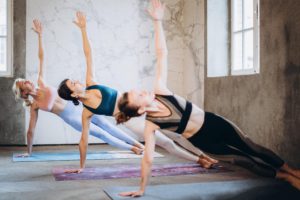INTRO
What is Stretching?

Stretching is a physical activity in which a specific muscle or group of muscles is deliberately elongated in order to improve flexibility and range of motion. Stretching is often an important part of physical activity and exercise, as it can help to warm up the muscles and prevent injury.
There are many different types of stretching, which can be done as standalone activities or as part of a larger exercise routine.
Starting a stretch challenge is a great way to involve someone else who might like to build a stretch habit with you.
Health Benefits of Stretching
Stretching can provide a number of health benefits, including:
Improved flexibility and range of motion
Stretching can help to improve the flexibility and range of motion of the muscles and joints, which can make it easier to perform daily activities, enhance athletic performance and reduce the risk of injury.
Improved posture
Stretching can help to improve posture by strengthening and lengthening the muscles that support the spine and other joints.
Reduced muscle tension
Stretching can help to relax tight muscles, which can reduce muscle tension and soreness.
Improved mood & stress relief
Stretching can help to reduce stress and promote relaxation through the release of feel-good endorphins.
Improved blood circulation
Stretching can help to improve blood circulation, which can help to deliver oxygen and nutrients to the tissues.
Better sleep
Through increased circulation and reduced muscle tension, stretching can improve sleep quality, particularly when done closer to bedtime.
Key Elements of Stretching

There are many different actions that can be utilized in your stretch challenge, but some of the most important include:
Warm-up: It’s important to warm up the muscles before stretching to help reduce the risk of injury. A light cardio activity, such as walking or jogging, can help to warm up the muscles.
Holding the stretch: Hold the stretch for at least 30 seconds to allow the muscles to become relaxed and elongated.
Proper technique: Proper technique is important when stretching to avoid straining or injuring the muscles. This includes using smooth, controlled movements and avoiding bouncing or jerking motions.
Gradual progression: Gradually increase the intensity and duration of stretches over time to avoid overstretching or straining the muscles.
Consistency: Stretching should be done regularly to maintain flexibility and range of motion. Try a stretch challenge with a friend to keep you consistent!
Deep breathing: Focusing on deep breathing during stretching can help to relax the muscles and improve the effectiveness of the stretch.
Diversify your Stretch Challenge
There are many different ways to practice stretching, depending on your goals and the equipment you have available.
Some options include:
Static stretching
This is the most common type of stretching and involves holding a stretch position for a period of time, typically 30 seconds or more.
Dynamic stretching
This involves actively moving the body through a full range of motion, such as swinging the leg back and forth or moving the arms in circles.
Self-myofascial release
This involves using props such as foam rollers or massage balls to stretch and release tension in the muscles.
Yoga
This ancient practice combines physical postures that involve stretching, breathing techniques, and meditation to improve flexibility, strength, and balance.
PNF stretching
PNF stands for proprioceptive neuromuscular facilitation, which involves contracting the muscle to be stretched, followed by a stretch, and then relaxing the muscle.
– Lidija, MasterHealth community member
Getting Started With a Stretch Challenge
1
Set a goal
Determine how often you want to stretch and for how long.
2
Start small
Begin with short stretches and gradually increase the duration over time.
3
Choose a consistent time
Select a specific time of day that works best for you to stretch, like the morning, evening or after a workout, or stretch throughout the day. Try to stretch at the same time every day to make it a habit.
4
Find a comfortable space
Designate a comfortable space where you can stretch without distractions or hazardous objects.
5
Make it enjoyable
Choose stretches that you enjoy and that feel good to your body.
6
Be patient
It takes time to develop a new habit, so be patient and don’t get discouraged if you don’t see results right away.
Overcoming Stretch Setbacks

When you’re just getting started with a stretch challenge, you might encounter some resistance to practice. Here are some solutions to common setbacks to stretching:
Lack of time: It can be difficult to find the time to stretch, especially if you have a busy schedule.
Set aside a specific time each day to stretch, even if it’s just for a few minutes.
Lack of motivation: It can be hard to stay motivated to stretch, especially if you don’t see immediate results.
Consider starting a stretch challenge with a friend or partner to stay motivated and accountable.
Pain or discomfort: Some people may experience pain or discomfort when stretching, which can be a deterrent.
If you are experiencing pain or discomfort when stretching, consider seeking guidance from a fitness professional or physical therapist to ensure you are using proper technique.
Lack of knowledge: Not knowing how to stretch properly or what stretches to do can be a barrier to regular stretching.
Before starting your routine, educate yourself about proper stretching techniques and what stretches are best for your body.
Common Questions
Stretching is important for a variety of reasons. It helps to improve flexibility and range of motion, which can reduce the risk of injury, improve athletic performance and help to maintain good posture.
Stretching also helps to prevent and reduce muscle soreness by increasing blood flow to the muscles and promoting the removal of waste products. Additionally, stretching can help to speed up recovery from injury by reducing inflammation and promoting healing.
Regular stretching can also help to reduce stress and tension in the body and promote a sense of relaxation and well-being. Furthermore, stretching helps to balance the body, counteracting the effects of prolonged sitting or inactivity, which can lead to muscle imbalances and eventually injury.
Yes, as you age, it’s generally recommended that you take a more gradual approach to stretching to avoid injury. Additionally, older adults may need to focus on exercises that maintain or improve flexibility, balance, and range of motion.
It’s also important to check with a healthcare professional before starting a new stretching or exercise routine, especially if you have any chronic health conditions.
Great question! It depends on the cause of the stiffness or soreness. In general, it is safe to stretch as long as you are not in pain. However, if your stiffness or soreness is caused by an injury or inflammation, it may be best to avoid stretching until you have seen a healthcare professional. They will be able to advise you on the best course of action for your specific condition.
If you are feeling stiff or sore due to inactivity or overuse, stretching can be beneficial to release tension, improve circulation, and reduce muscle soreness. However, it is important to start slowly and gently to avoid further injury. It’s recommended to do a warm-up before stretching, such as light cardio or a dynamic stretching routine, this will help your muscles to be more prepared for the stretch, and it will also decrease the risk of injury.
It’s always important to listen to your body, if something doesn’t feel right, stop stretching and seek professional advice.
We all know how satisfying it feels to stretch after sitting for a long time, like after a long car ride! It can also feel refreshing after a good workout. There are several reasons why stretching can feel good, including:
- Relaxation: Stretching can help to relax the muscles and release tension, which can lead to a feeling of relaxation and well-being.
- Improved circulation: Stretching can increase blood flow to the muscles, which can promote the removal of waste products and bring oxygen and nutrients to the muscles. This increased blood flow can also help to reduce muscle soreness.
- Release of endorphins: Stretching can stimulate the release of endorphins, which are chemicals in the brain that act as natural painkillers and mood elevators.
- Improved posture: Stretching can help to improve posture by strengthening the muscles that support the spine and reducing tension in the back, shoulders and neck.
- Increased flexibility: Stretching can improve flexibility, which can make movement feel less restrictive and more comfortable.
- Mindfulness: Stretching often requires focus and concentration, so it can be a way to be more mindful and present in the moment.
Overall, stretching can be a great way to relax, release tension, and promote a sense of well-being.
Ways to Support Your Stretch Habit
There are several support systems that you can use for your stretch challenge, including:
Fitness professionals: Personal trainers, physical therapists, and other fitness professionals can provide guidance on proper stretching techniques and help you develop a stretching routine that is tailored to your needs and goals.
Online resources: There are many online resources, such as videos, tutorials, and stretching guides, that can provide information and instruction on how to stretch properly.
Apps: There are a number of apps that offer stretching routines and guidance, which can be a convenient and portable way to stay on track with your stretching. Stretching is also built into most fitness apps.
Exercise classes: Some exercise classes, such as yoga or Pilates, focus on stretching and can provide a structured and supportive environment for improving flexibility.
Support groups: Joining a support group or online community of people who are also working on improving their stretching habits can provide motivation and accountability. The MasterHealth community is a great place to start!










